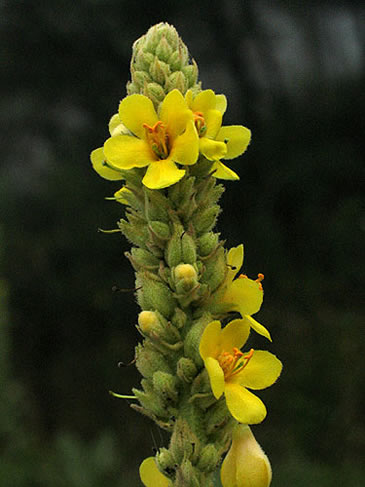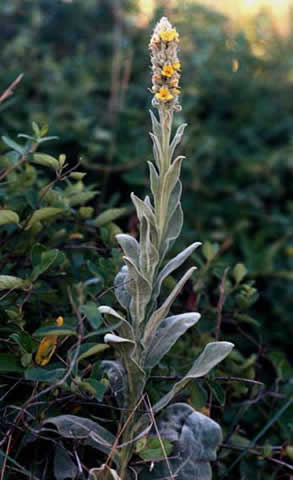
Folklore: An old superstition existed that witches used lamps and candles provided with wicks of Mullein in their incantations, and another of the plant's many names, 'Hag's Taper', refers to this. Both in Europe and Asia the power of driving away evil spirits was ascribed to the Mullein. Being a sure safeguard against evil spirits and magic, and from the ancient classics, it was this plant which Ulysses took to protect himself against the wiles of Circe.
The leaves (first season) at the base of the stem form a rosette of numerous, large, 6 to 15 inches long and up to 5 inches broad, but become smaller as they ascend the stem, on which they are arranged on alternate sides. They are whitish with a soft, dense mass of hairs on both sides, which make them feel very furry and thick. The root is a long taproot with a fibrous outer cover and fleshy inside. The flower-spike (second season) has been known to attain a height of 7 or 8 feet, covered with densely crowded, sulphur-yellow, flowers about an inch across with five rounded petals. Blooming during July and August. Harvest the entire plant when in bloom and dry for later herb use.
Properties: The whole plant possess slightly sedative and narcotic properties. The seeds are mostly used as a narcotic and also contain saponins. The dried leaves are sometimes smoked to relieve the irritation of the respiratory mucus membranes, and the hacking cough of consumption. They can be employed with equal benefit when made into cigarettes, for asthma and spasmodic coughs in general. Externally, a medicinal poultice of the leaves is applied to sunburn, ulcers, tumors and piles. A decoction of the seeds is used to soothe chillblains and chapped skin.
